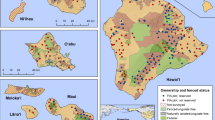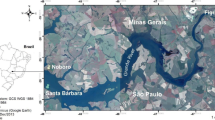Abstract
Tropical forests are suffering from increasing intensities and frequency of disturbances. As a result, non-native species accidentally introduced or intentionally planted for farming, plantations, and ornamental purposes may spread and potentially invade undisturbed native forest. It is not known if these introduced species will become invasive, as a result of recurrent natural disturbances such as hurricanes. Using data from three censuses (spanning 15 years) of a 16-ha subtropical wet forest plot, we investigated the impact of two hurricanes on populations of plant species that were planted in farms and plantations that were then abandoned and from the natural spread of species introduced into Puerto Rico in the past. The populations of four species (Citrus paradis, Mangifera indica, Musa sp., and Simarouba glauca) changed little over time. Six species (Artocarpus altilis, Calophyllum calaba, Genipa americana, Hibiscus pernambucensis, Syzygium jambos, and Swietenia macrophylla) declined between the first two censuses after Hurricane Hugo, then increased again in Census 3 after Hurricane Georges. Spathodea campanulata gradually increased from census to census, while Coffea arabica declined. These introduced species represent only a small part of the forest basal area and few show signs of increasing over time. The number of stems per plant, new recruits, and the growth rates of these introduced species were within the ranges of those for native plant species. The mortality rates over both census intervals were significantly lower for introduced species (<5% year−1) than for native ones (15% year−1). Many new recruits established after Hurricane Hugo (prior to this study) had opened the forest canopy and these high mortality rates reflect their death as the canopy recovered. Only Swietenia macrophylla and Syzygium jambos showed an increase in stem numbers in the closed canopy area of forest that had suffered limited human disturbance in the past. A future increase in frequency of disturbance may enable greater stem numbers of introduced species to establish, while lower-mortality rates compared to native species, may allow them to persist during inter-hurricane intervals. An increase in the population of introduced species, especially for those that grow into large trees, may have an impact on this tropical forest in the future.





Similar content being viewed by others
References
Bellingham PJ, Tanner EVJ, Healy JR (2005) Hurricane disturbance accelerates invasion by the alien tree Pittosporum undulatum in Jamaican montane rain forests. J Veg Sci 16:675–684
Brown S, Lugo AE, Silander S et al (1983) Research history and opportunities in the Luquillo Experimental Forest. USDA Forest Service General Technical Report SO-44, Southern Forest Experimental Station, New Orleans
Brown KA, Scatena FN, Gurevitch J (2006) Effects of an invasive tree on community structure and diversity in a tropical forest in Puerto Rico. Forest Ecol Manage 226:145–152
Burslem DFRP, Whitmore TC, Brown GC (2000) Short term effects of cyclone impact and long-term recovery of tropical rain forest on Kolombangara. Solomon Islands J Ecol 88:1063–1078
Chinea JD (1999) Changes in the herbaceous and vine communities at the Bisley Experimental Watersheds, Puerto Rico, following Hurricane Hugo. Can J For Res 29:1433–1437
Condit R (1998) Tropical forest census plots: methods and results from Barro Colorado Island, Panama, and a comparison with other plots. Springer, Berlin, Heidelberg, New York
Condit R, Hubbell SP, Foster RB (1995) Mortality rates of 205 neotropical tree and shrub species and the impact of a severe drought. Ecol Monogr 65:419–439
Elton CS (1958) The ecology of invasions by animals and plants. John Wiley and Sons, New York
Ewel JJ, O’Dowd DJ, Bergelson J et al (1999) Deliberate introductions of species: research needs. BioScience 49:619–630
Ewel JJ, Putz FE (2004) A place for alien species in ecosystem restoration. Front Ecol 2:354–360
Foster DR, Fluet M, Boose ER (1999) Human pr natural disturbance:landscape dynamics of the tropical forests of Puerto Rico. Ecol Appl 9:555–572
Francis JK (1993) Genipa americana L. Jagua, genepa. Research note SO-ITF-SM58. USDA Forest Service Southern Forest Experimental Station, New Orleans
Francis JK (2000a) Spathodea campanulata. In: Francis JK, Lowe CA (eds) Silvics of native and exotic trees of Puerto Rico and the Caribbean Islands. USDA Forest Service General Technical Report IITF-15, Puerto Rico
Francis JK (2000b) Syzygium jambos (Rose apple). In: Francis JK, Lowe CA (eds) Silvics of native and exotic trees of Puerto Rico and the Caribbean Islands. USDA Forest Service Gen Technical Report IITF-15, Puerto Rico
Francis JK, Liogier HA (1991) Naturalized exotic tree species in Puerto Rico. General Technical Report SO-82, USDA, Forest Service, Southern Forest Experiment Station, New Orleans
Gerhart GA (1934) Tract 11. Land acquisition supplementary report, Luquillo purchase unit. Caribbean National Forest. USDA Forest Service. Open file report. International Institute of Tropical Forestry, Catalina Service Station, Palmer, Puerto Rico
He HS, DeZonia BE, Mladenoff DF (2000) An aggregation index (AI) to quantify spatial patterns of landscapes. Landsc Ecol 15:591–601
Haber A, Runyan RP (1973) General statistics. Addison Wesley, London, New York
Horvitz CC, Pascarella JB, McMann S et al (1998) Functional roles of invasive non-indigenous plants in hurricane-affected subtropical hardwood forests. Ecol Appl 8:947–974
Küffer C (2006) Impacts of woody invasive species on tropical forests of the Seychelles. Dissertation, ETH, Zurich
Lawesson JE (1990) Alien plants in the Galapagos Islands, a summary. Monogr Syst Bot Mo Bot Gdn 32:15–20
Logier HA (1985, 1988, 1994, 1995, 1997) Descriptive flora of Puerto Rico and adjacent islands: Vols 1, 11, 111, 1V and V. Editorial de la Universidad de Puerto Rico, Rio Piedras
Little EL Jr, Woodbury RO (1976) Trees of the Caribbean National Forest, Puerto Rico Forest Service Research Paper ITF-20. International Institute of Tropical Forestry, Rio Piedras
Lugo AE (2004) The outcome of alien tree invasions in Puerto Rico. Front Ecol Environ 2:265–273
Lugo AE, Helmer E (2004) Emerging forests on abandoned land: Puerto Rico’s new forests. Forest Ecol Manage 190:145–161
Lugo AE, Scatena F (1995) Ecosystem-level properties of the Luquillo Experimental Forest In: Lugo AE, Lowe C (eds) Tropical forests: management and ecology. Springer, Berlin, Heidelberg, New York
McGarigal KS, Cushman A, Neel MC et al (2002) FRAGSTATS: spatial pattern analysis program for categorical maps. University of Massachusetts, Amherst
Medina E, Wang HH, Lugo AE et al (2003) Growth-, water-, and nutrient-related plasticity in hybrid mahogany leaf development under contrasting light regimes. In: Lugo AE, Figueroa JC, Alayón M (eds) Big-leaf mahogany: genetics, ecology, and management. Springer, Berlin, Heidelberg, New York
Merlin M, Florence J (1996) Tahiti’s native flora endangered by the invasion of Miconia calvescens. J Biogeogr 23:775–781
Muthana KD, Arora GD (1983) Prosopis juliflora (Swatz) DC., a fast growing tree to bloom in the desert. CAZRI Monogr 22:1–21
Nyoka BI (2003) Biosecurity in forestry: a case study on the status of invasive forest trees species in Southern Africa. Forest Biosecurity Working Paper FBS/1E. Forestry Department. FAO, Rome
Ostertag R, Silver WL, Lugo AE (2005) Factors affecting mortality and resistance to damage following hurricanes in rehabilitated subtropical moist forest. Biotropica 37:16–24
Parrotta JA (1994) Artocarpus altilis (S. Park P Fosb). Breadfruit, Breadnut. SO-ITF-SM-71. Department of Agriculture, Forest Service, Southern Forest Experimental Station, New Orleans
Pascarella JB, Aide TM, Serrano MI et al (2000) Land-use history and forest regeneration in the Cayey Mounatins, Puerto Rico. Ecosystems 3:217–228
Pasiecznik NM, Felker P, Harris PJC et al (2001) The Prosopis juliflora–Prosopis pallida complex: a monograph. HDRA, Coventry
Richardson DM, Pysek MR, Michael GB et al (2000) Naturalization and invasion of alien plants: concepts and definitions. Divers Distrib 6:93–107
Thompson J, Brokaw N, Zimmerman JK et al (2002) Land use history, environment, and tree composition in a tropical forest. Ecol Appl 12:1344–1363
Shono K, Snook LK (2006) Growth of Big-Leaf Mahogany (Swietenia macrophylla) in natural forest in Belize. J Trop For Sci 118:66–73
Snook LK (1996) Catastrophic disturbance, logging and the ecology of mahogany (Swietenia macrophylla): grounds for listing a major tropical species in CITES. Bot J Linn Soc 122:35–46
Scatena FN, Larson MC (1991) Physical aspects of Hurricane Hugo in Puerto Rico. Biotropica 23:317–323
Scatena FN, Lugo AE (1995) Geomorphology, disturbance, and the soil and vegetation of two subtropical wet steepland watersheds of Puerto Rico. Geomorphology 13:199–213
Soil Survey Staff (1995) Order 1 Soil Survey of the Luquillo Long-Term Ecological Research grid Puerto Rico. USDA, Natural Resources Conservation Service, Lincoln, Nebraska
Van Bloem SJ, Murphy PG, Lugo AE et al (2005). The influence of hurricane winds on Caribbean dry forest structure and nutrient pools. Biotropica 37:571–583
Walker LR (1991) Tree damage and recovery from Hurricane Hugo in Luquillo experimental forest. Biotropica 23:379–385
Walker LR, Voltzow J, Ackerman JD et al (1992) Immediate impact of Hurricane Hugo on a Puerto Rican Rain Forest. Ecology 73:691–694
Waide RB, Reagan DP (1996) The rain forest setting. In: Reagan DP, Waide RB (eds) The food web of a tropical rain forest. University of Chicago Press, Chicago
Zimmerman JK, Everham EM III, Waide RB et al (1994) Responses of tree species to hurricane winds in subtropical wet forest in Puerto Rico: implications for tropical tree life histories. J Ecol 82:911–922
Acknowledgments
This article is dedicated to John Proctor who was Jill Thompson’s teacher and mentor during her undergraduate education at Stirling University. John Proctor invited Jill to participate in the Maracá Project in Brazil that was (organised by the Royal Geographical Society, London) and as a result she has enjoyed wonderful times in tropical forests. John was a unique and special person and he will be greatly missed as a colleague and friend. We are grateful for the work of many people who have helped inventory the LFDP over several censuses and are too numerous to mention by name. The LFDP was established with funds from the National Science Foundation (NSF) SGER grant BSR-90159561 to University of Puerto Rico (UPR) and supported by NSF grants to the Luquillo LTER BSR-8811902 and BSR-8811764 to the Institute for Tropical Ecosystem Studies. The U.S. Forest Service (Department of Agriculture) gave additional support. Funds were also provided through grants R11-880291 and HRD-935349 from NSF to UPR’s Center for Research Excellence in Science and Technology. We are grateful to the Andrew Mellon Foundation, which funded the third census.
Author information
Authors and Affiliations
Corresponding author
Rights and permissions
About this article
Cite this article
Thompson, J., Lugo, A.E. & Thomlinson, J. Land use history, hurricane disturbance, and the fate of introduced species in a subtropical wet forest in Puerto Rico. Plant Ecol 192, 289–301 (2007). https://doi.org/10.1007/s11258-007-9318-5
Received:
Accepted:
Published:
Issue Date:
DOI: https://doi.org/10.1007/s11258-007-9318-5




